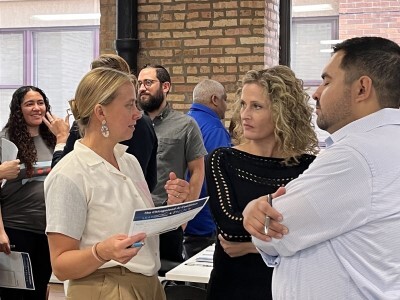Technology Tools
Open Learning Objectives
Topics

Educators often take advantage of educational technologies as they make the shifts in instruction, teacher roles, and learning experiences that next gen learning requires. Technology should not lead the design of learning, but when educators use it to personalize and enrich learning, it has the potential to accelerate mastery of critical content and skills by all students.
OpenEd and the Learning Accelerator have partnered to create a list of open learning objectives. Learn how you can use them and support the effort.
Teachers instinctively see the value of personalizing education for each student. However, without infinite hours in the day, there is no practical way to help each student individually—and in fact, no way to even gauge the needs of each student. Software has promised to help close this gap in helping understand where students are, but with varying success to date.
One reason teachers can’t gauge the needs of each student is the lack of a standard, open taxonomy of learning objectives that any district, company, or organization can use for free. In particular, Open Learning Objectives would help any organization working on mastery-based or personalized learning.
At the most basic level, having a trusted, free taxonomy of objectives aligned to learning and assessment resources available for educators will save time in districts everywhere. And of course, a more granular taxonomy will help teachers and students succeed in any personalized learning scenario.
Why Are Standards Not Enough?
State education standards designate what students should learn. Despite what some would argue, they are written for humans—teachers and students, primarily—to show what students need to learn. But these standards are often not specific enough for technology to help educators quickly adjust resources and assess results. The power and promise of personalized learning is unachievable without clear, shared, and specific learning objectives.
Here is an example. In Common Core 4.G.A.1, the standard shows that the student must learn how to draw points, lines, rays, right angles, acute angles, and more. This arguably works fine for a teacher, but a computer doesn’t know what to make of it. If you have a room full of 4th graders trying to master these skills, some will have mastered all, some none, but most likely you have a mixture of kids with different mastery of the different objectives.
Edtech software can help the teacher understand which students are missing mastery, on what skills, and help recommend resources for each student to help them over the humps. However, without a detailed list of skills—a taxonomy—there is no way for the software to do this effectively. A taxonomy fosters the creation of and search for more specific educational content, which can be represented as metadata. It also fosters more granular mastery determination.
Every year educators across the country spend many hours creating learning objectives based on their state standards and breaking them down to varying levels of detail for their districts and their classrooms. This work is entirely redundant; if teachers had a trusted source of detailed objectives, they could save this time and focus on other activities to engage students and give better feedback.
Many states do not use Common Core. Therefore, creating taxonomies based on Common Core is not ideal. At OpenEd, we believe a flat list of objectives that can be easily mapped to Common Core, or Texas TEKS, Florida MAFS/LAFS, etc. is the best way to achieve an open taxonomy that can map to any state standard.
What Are the Open Learning Objectives?
The Learning Accelerator and OpenEd have partnered to create a list of specific learning objectives for K-8 mathematics. These objectives are structured to enable competency-based learning. They also cover all of the content in the Common Core standards for math for these grades.
Our goal is to make these available for free to every teacher in the country. We hope this will be helpful for teachers and serve as a starting point for them to implement competency-based learning in the months and years ahead. But even if teachers don't move toward competency-based learning, we hope this list can save teachers many hours of work creating their own learning objectives.
The Open Learning Objectives are a shared project that anyone can join.
To date, we have created open learning objectives for K-5 Math, with mapping to Common Core. You will also see drafts for grades 6-8 math. Algebra I, Geometry, and K-5 ELA objectives are also forthcoming.
Want to Join?
The exciting thing about open source projects is that anyone can contribute! We are looking for other organizations or people who would like to contribute to the project by helping to create objectives, suggesting how they can be used most effectively by students and teachers, or providing funding to expand the project. If you are interested please contact Scott Ellis.




